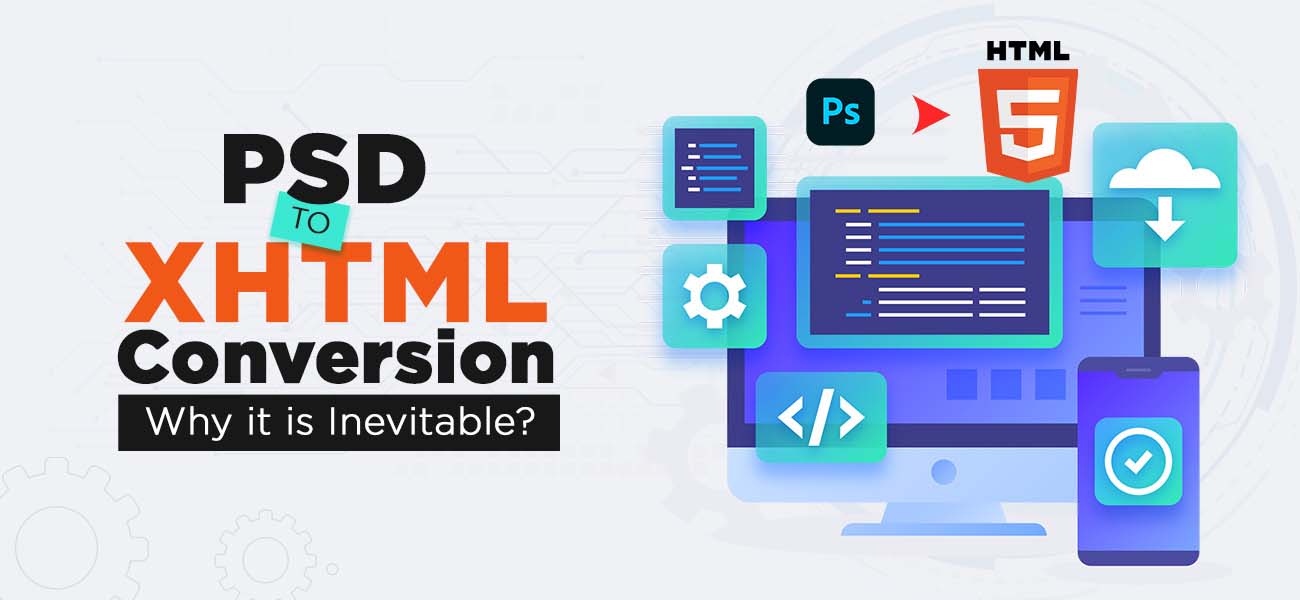The Ultimate Guide to PSD to XHTML Conversion for Modern Web Design
A great design means nothing if it can’t go live. Businesses invest heavily in eye-catching interfaces, but without clean, functional code, those PSD files are just visuals gathering digital dust. PSD to XHTML conversion bridges the gap between concept and usability—turning layered Photoshop designs into browser-ready markup.
For development teams and agencies focused on performance, precision, and compatibility, this step is essential. Whether you're launching a SaaS product, revamping a corporate site, or building out a responsive frontend, converting design into structured XHTML helps ensure a smooth, scalable, and standards-compliant web presence.

What is PSD to XHTML Conversion?
A PSD is a Photoshop Design File—a layered image created using Adobe Photoshop. It visually represents a website's design, including layout, colors, fonts, and interactive elements. Designers use PSDs to provide developers with a static blueprint of how the final site should look.
XHTML (Extensible Hypertext Markup Language) is a stricter, XML-based version of HTML. It enforces cleaner coding practices and promotes long-term maintainability. XHTML web design is widely preferred for its structured and standards-compliant nature, making websites more scalable and compatible across browsers.
Process of PSD to XHTML Conversion
-
Analyze the PSD File
Review the Photoshop design to understand layout sections like header, footer, navigation, content, and interactive elements. Identify fonts, colors, icons, and effects.
-
Slice the PSD
Extract individual design elements (buttons, banners, backgrounds, etc.) from the PSD using slicing tools in Photoshop. These slices are saved as images (e.g., PNG, JPEG) for use in the web layout.
-
Create the XHTML Structure
Open a code editor and start writing the XHTML markup. Use semantic HTML tags (like < header >, < nav >, < section >, etc.) while ensuring that you follow XML rules—like properly closing all tags and nesting elements correctly.
-
Apply CSS Styling
Link an external CSS file to style the XHTML layout. Replicate the exact visual look of the PSD—fonts, margins, paddings, background colors, hover effects—using clean and responsive CSS.
-
Make it Responsive (Optional but Recommended)
Use media queries and flexible grids to ensure the XHTML layout adapts well to mobile devices and different screen sizes.
-
Test and Validate the Code
Run your XHTML and CSS through W3C validators to ensure compliance with web standards. Cross-browser testing is also crucial to verify consistency.
-
Optimize and Finalize
Optimize images, minify CSS, and clean up any unused code. This improves page load speed and performance.
This conversion process bridges the gap between static design and functional web interface—laying the foundation for clean, scalable front-end development.
Why Does XHTML Still Matter in 2025?
You might wonder, in the age of modern JavaScript frameworks and HTML5, does XHTML still hold relevance? Absolutely. The benefits of XHTML are rooted in its structured approach. Unlike flexible HTML, XHTML forces consistency. This matters for developers working on long-term, maintainable projects.
XHTML enforces W3C-validated code, meaning fewer rendering errors across browsers and devices. The markup is semantic and clean, contributing to better indexing by search engines and improved accessibility. For businesses with large-scale, enterprise-grade websites or email systems, XHTML offers both reliability and control.
Top Benefits of PSD to XHTML Conversion
-
Clean and Structured Code
XHTML’s strict syntax ensures your codebase remains organized and maintainable. This reduces bugs and enhances collaboration between developers. Whether you are building a new frontend or redesigning an existing one, digital conversion services that deliver XHTML output give you future-proof assets that integrate easily with content management systems.
-
Faster Load Time
XHTML allows for lean, optimized code. When you convert PSD to XHTML, unnecessary elements are eliminated, reducing page weight. Faster load times improve user experience and lower bounce rates—critical for SaaS and e-commerce businesses.
-
Cross-Browser Compatibility
One of the underrated benefits of XHTML is that it behaves consistently across browsers. Modern businesses can’t afford a design that breaks on Safari or Internet Explorer. XHTML’s discipline ensures your website looks the same—everywhere.
-
Pixel-Perfect Design Accuracy
For creative agencies and UI/UX-focused brands, accuracy is everything. With XHTML’s structured approach, every element from the original PSD is translated with precision. This level of detail guarantees that branding and visual identity are preserved down to the pixel.
-
SEO-Friendliness
Clean markup matters to search engines. With semantic structure and cleaner code, search engines can better crawl and rank your pages. Combined with other front-end development best practices, XHTML ensures your pages are both user- and crawler-friendly.
PSD to XHTML vs PSD to HTML5: What’s the Difference?
The key difference between XHTML and HTML5 lies in syntax rules and use cases. XHTML follows strict XML-based rules. All tags must be properly closed, nested, and written in lowercase. This makes the code cleaner and reduces errors during rendering. It’s ideal for projects where structure, long-term maintainability, and backward compatibility are essential—such as email templates, CMS integrations, or legacy enterprise systems.
HTML5, on the other hand, is more flexible. It allows unclosed tags, mixed-case elements, and looser syntax. It supports multimedia content, dynamic elements, and advanced JavaScript APIs, making it better for modern, interactive websites.
If your project requires semantic markup, reliable validation, and compatibility with older systems, XHTML is a better fit. For highly interactive, JavaScript-heavy applications, HTML5 offers more flexibility and modern features. The right choice depends on your specific front-end development best practices and project goals.
Use Cases: Who Needs PSD to XHTML Today?
While newer formats exist, XHTML still finds strong demand in several industries and workflows. Agencies working with branding-specific clients often demand pixel-perfect rendering, where responsive XHTML design ensures that every screen displays content consistently.
Freelancers handling static websites, newsletters, or CMS themes appreciate XHTML’s predictable structure. SaaS businesses that depend on fast-loading, secure, and compliant interfaces choose XHTML for maintainability and speed.
Enterprise websites using legacy systems often still require XHTML over HTML5 due to compatibility constraints. In all these cases, businesses frequently convert PSD to XHTML to deliver well-structured, device-friendly code ready for implementation.
Common Challenges in PSD to XHTML Conversion
Despite its advantages, PSD to XHTML isn’t without its difficulties. Here are some common pain points and ways to overcome them:
-
Rendering Issues
Older browsers might not fully support certain CSS properties. You can solve this by using fallback styles or tools like BrowserStack to test across environments.
-
Responsive Layouts
Designs built only for desktops need careful planning to translate into mobile-friendly XHTML. Frameworks like Bootstrap or custom CSS media queries help adapt layouts without breaking the structure.
-
Manual Validation
Since XHTML requires clean and strictly valid markup, even a single unclosed tag can break the page. Use validators like the W3C Validator or integrate IDE plugins to catch these issues early. By planning ahead and leveraging modern tools, these challenges can be minimized.
How to Choose the Right PSD to XHTML Conversion Service?
Outsourcing PSD to XHTML conversion can save time and ensure quality—but not all services are equal. Here’s what to look for:
-
Code Quality
Choose providers who deliver clean, well-commented, and W3C-validated code. Poorly written markup leads to rendering issues and affects SEO.
-
Turnaround Time
Speed matters. Agencies and businesses often work on tight deadlines, so ensure your partner offers quick delivery without compromising on quality.
-
Support & Revisions
Revisions are inevitable. A reliable service should offer post-delivery support and be open to making reasonable adjustments based on your feedback.
-
Specialized Expertise
Look for developers with strong experience in digital conversion services and XHTML-specific front-end work. They shall understand nuances that generic coders might miss.
Hiring professionals ensures the final output aligns with both visual expectations and technical standards.
Conclusion
PSD to XHTML conversion remains a vital process for businesses aiming to bridge the gap between design vision and functional implementation. XHTML’s structured nature offers clean, semantic code that performs well, ranks better, and renders consistently across devices and browsers. From precision in layout to long-term maintainability, XHTML still holds its ground in modern front-end workflows.
Whether you are an agency, developer, or business leader, embracing professional XHTML conversion services can elevate your web presence—ensuring a smooth, high-performing, and future-ready digital experience. It’s not just about looks anymore—it’s about usability, performance, and control.
Frequently Asked Questions
Slice the PSD design into individual elements using Photoshop. Export assets (images, icons), then write clean HTML5 for structure and CSS3 for styling. Add JavaScript if interactivity is needed. Finally, test responsiveness and browser compatibility before deploying the HTML file.
PSD to HTML transformation is the process of converting a static Photoshop design (PSD) into a functional web page using HTML, CSS, and JavaScript. It involves slicing the design, writing semantic code, and creating a responsive, browser-compatible website layout.
Using a CMS like WordPress allows seamless integration of HTML designs into dynamic templates. It enables easy content management, scalability, plugin support, and faster deployment while retaining the original PSD layout and design integrity.
Use design systems and UI kits, automate asset slicing, leverage CSS frameworks like Bootstrap, and implement code snippets or pre-built templates. Efficient planning and version control tools can also streamline collaboration and reduce turnaround time.
PSD to HTML ensures pixel-perfect translation of design to code, preserving visual accuracy. It offers customization, better control over front-end code, responsiveness, and SEO-friendliness—ideal for tailored web experiences and performance optimization.



